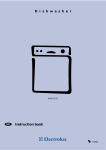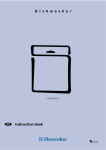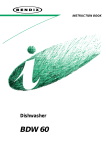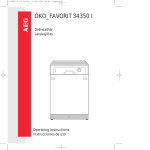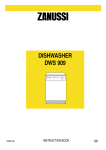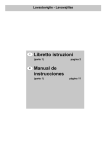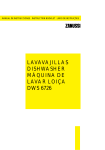Download AEG 2073-4 GS Freezer User Manual
Transcript
152982 05/1 en 14-04-2000 11:00 Pagina 1 FAVORIT 2807 Dishwasher Operating instructions 152982 05/1 en 14-04-2000 11:00 Pagina 2 Dear customer! Please read these user instructions carefully. Above all please observe the safety instructions on the first few pages of these user instructions! Please keep these user instructions for later reference. Pass them on to any subsequent owner of the appliance. The warning triangle and/or specific words (Warning!, caution!, Important!) are used to highlight instructions that are important for your safety or for the function of the appliance. It is imperative that these instructions are observed. This symbol or numbered instruction steps lead you step by step through the operation of the appliance. Next to this symbol you receive additional information and practical tips on using the appliance. Tips and instructions for the economical and environmentally conscious use of the appliance are marked with a clover leaf. In the event of a malfunction, these operating instructions contain information on how to rectify faults yourself, see "What to do, when..." section. If these instructions are insufficient, please contact your nearest customer service centre. In the case of technical problems, our customer service organisation is available to provide you with assistance at any time. Printed on paper manufactured with environmentally sound processes. He who thinks ecologically acts accordingly... 2 152982 05/1 en 14-04-2000 11:00 Pagina 3 Contents Safety instructions 4 Disposing of packaging and old machine Disposing of the packaging Disposing of your old machine Economical and ecological dishwashing 6 6 6 7 Description of the appliance The inside of the appliance Control panel Before using your dishwasher for the first time Setting the water hardness range Filling with special salt The rinse aid 8 8 9 10 10 11 13 Loading cutlery and dishes The lower basket Cutlery basket The upper basket Use of detergent Compact detergents with enzymes 15 16 17 18 20 21 Washing programmes 22 Operating instructions 24 Maintenance and cleaning Internal and external cleaning Cleaning the filters 26 26 26 What do do, when... 28 Customer service 30 Technical data 31 Hints for test centres 32 Installation 33 Connection instructions Water supply connections Water outlet connection Extension hoses Electrical connection 34 34 35 36 36 3 152982 05/1 en 14-04-2000 11:00 Pagina 4 Safety instructions The safety of AEG electrical appliances conforms to accepted rules of technology and the Appliance Safety Act. We as manufacturers, however, see ourselves as being obliged to familiarise you with the following safety instructions. Using your dishwasher for its intended purpose ● Only use your dishwasher for machine washing of household crockery. If your machine is misused or used for any purposes other than that for which it is intended, the manufacturer cannot be held liable for any damage caused. ● For safety reasons, you should not convert or modify your dishwasher in any way. Before using your dishwasher for the first time ● Check your dishwasher for any transport damage. Never connect a damaged machine. If your dishwasher is damaged, you should contact your supplier. ● Your dishwasher must be correctly installed and connected. Please read the section on "Installation" to make sure you know all about this. ● Before using your dishwasher for the first time, do not forget that the nominal voltage and current type indicated on the rating plate of your machine must be the same as the nominal voltage and current type at the installation site. The necessary electrical fusing is also given on the rating plate. Child safety ● Packaging parts (e.g. foils, styrene foam) may be dangerous for children,who could even be suffocated! You should therefore keep all packaging well away from children. 4 ● Children may not recognise the dangers of improper use of electrical appliances. You should therefore ensure proper supervision during operation and not allow your children to play with your dishwasher. ● Detergents may have a caustic effect on eyes, mouth and throat and may even cause suffocation! Keep all detergents in a safe place out of children’s reach. 152982 05/1 en 14-04-2000 11:00 Pagina 5 ● The water in your dishwasher should not be used for drinking. Detergent residues may still be present in your machine. Make sure you do not splash these caustic residues onto your skin or suffocate yourself! Keep children well away from your dishwasher when its door is open. Your dishwasher in day-to-day use ● Never operate your dishwasher if the electrical supply lead, supply or drainhose, control panel, worktop or plinth are damaged. ● If there is a fault, first turn the water tap off. Then switch off your machine and pull the plug out of the socket. If there is a fixed connection, switch off or unscrew the fuse(s). ● Never pull the plug out of the socket by the cable - always hold the plug. ● Dishwasher repairs should only be performed by trained personnel. Improper repairs may seriously endanger the user. If your dishwasher needs to be repaired, you should contact our service centre or your retailer. ● Never place any solvents in your dishwasher or you may cause an explosion! ● Do not rest or sit on the open door or the machine could tilt. ● Before using special dishwasher salt, detergent or rinse-aid, make sure that the manufacturer of these products expressly specifies their use in domestic dishwashers. ● Always turn off the water tap when your dishwasher is left unattended for any length of time, e.g. when you are away on holiday. ● Only transport the dishwasher in an upright position. Tipping it upside down during transport could cause salty water to leak into the internal compartment and lead to the formation of rust. 5 152982 05/1 en 14-04-2000 11:00 Pagina 6 Disposing of packaging and old machine Disposing of the packaging Our dishwashers require effective protective packaging in transit, though we always confine ourselves to what is absolutely necessary. Warning! Packaging parts (e.g. foils, styrene foam) may be dangerous for children, who could even be suffocated! You should therefore keep all packaging well away from children. All packaging materials used are environmentally compatible and reusable. The cardboard parts are produced from recycled paper, and the wood is untreated. The plastics are marked as follows: >PE< for polyethylene, e.g. packaging foils. >PS< for polystyrene, e.g. padding (essentially CFC-Free). >POM< for polyoxymethylene, e.g. plastic clamps. Give the packaging for reuse to your local recycling centre. Your municipal or local authority will give you its address. Disposing of your old machine When your machine finally reaches the end of its life and you withdraw it from service, you should render it unserviceable before having it disposed of. Warning! Children at play could lock themselves in your machine (and suffocate) or otherwise endanger their lives. Therefore pull out the main plug and detach and discard the electrical supply lead. Disable the door lock so that the door no longer closes. Marking of plastic parts for graded recycling: all plastic parts in your machine are marked with internationally standardised abbreviations (e.g. <PS> for polystyrene). When your machine is disposed of, this enables plastic waste to be sorted into individual types for environmentally conscious recycling. Take your decommissioned machine to your local recycling centre or dealer, who will take it back from you for a small handling charge. 6 152982 05/1 en 14-04-2000 11:00 Pagina 7 Economical and ecological dishwashing ● Only connect the dishwasher to the hot water supply if your hot water is not electrically heated. ● Ensure that the water softener is correctly adjusted. ● Do not pre-rinse under running water. ● Select the wash programme to suit the nature and degree of the soiling on the dishes. ● Do not use more detergent, special salt or rinse aid than is recommended in these operating instructions and by the manufacturer of the respective product. 7 152982 05/1 en 14-04-2000 11:00 Pagina 8 Description of the appliance The inside of the appliance 14 1 2 3 13 12 11 4 10 5 6 9 8 7 IN68 1. Water hardness adjustment 12. Upper spray arm 2. Levelling spacers 13. Upper basket 3. Upper basket stop 14. Worktop 4. Salt container 5. Large filter 6. Detergent dispenser 7. Control panel 8. Rating plate 9. Rinse aid dispenser 10. Central filter 11. Lower spray arm 8 152982 05/1 en 14-04-2000 11:00 Pagina 9 Control panel 1. On/Off indicator light 2. On/Off push button 3. Main wash temperature push buttons 4. "Half load" push button If you select this option, washing will be confined to the only lower basket. In this case always remember to load crockery , cutlery, pots and pans only in the lower basket. 5. Programme guide 6. Door handle 7. Salt refilling indicator light 8. Programme marker 9. Programme selector dial 9 152982 05/1 en 14-04-2000 11:00 Pagina 10 Before using your dishwasher for the first time 1. Ensure that the electrical and water connections comply with the installation instructions. 2. Remove all packaging from inside the appliance. 3. Set the water softener. 4. Pour 1 litre of water inside the salt container and then fill with salt. 5. Fill the rinse-aid dispenser. Setting the water hardness range The dishwasher is equipped with a water softener designed to remove minerals and salts from the water supply, which would have a detrimental or adverse effect on the operation of the appliance. The higher the content of these salts, the harder your water is. Water hardness is measured in equivalent scales, German and French. The softener should be adjusted according to the hardness of the water in your area. To ensure optimum regeneration of the water softener: - the water softenening must be set to the local water hardness; - the dishwasher salt container must always be filled with special salt. Your local Water Authority can advise you on the hardness of the water in your area. The dishwasher is factory set at level 2. If this level is not suitable for your area the softener should be adjusted. Water hardness Level °dH °TH (german degrees) (french degrees) 0 1 2 3 4 5 10 0-4 5 - 11 12 - 22 23 - 34 35 - 45 46 - 50 0-8 9 - 20 21 - 40 41 - 60 61 - 80 81 - 90 (parts per million) Use of salt 0 - 80 81 - 200 201 - 400 401 - 600 601 - 800 801 - 900 NO YES YES YES YES YES PPM With a screwdriver turn the selector on the upper front corner of the machine until the level required corresponds with the marker. 3 4 152982 05/1 en 14-04-2000 11:00 Pagina 11 5 2 2 1 AA05 If your water is level 0 it is already soft and therefore there is no need to use salt. In this case adjust the water softener on level 1 without using salt. The salt indicator on the control panel will always remain illuminated when the machine is switched on. Filling with special salt Caution! The packaging of dishwasher salt and detergents are often very similar. The accidental filling of the salt compartment with detergent would ruin the water softener. Each time you add salt, make sure the carton you have in your hand really is salt. Only use salt specifically designed for use in dishwashers. All other types of salt not specifically designed for use in a dishwasher, especially table salt, will damage the water softener. Only fill with salt just before starting one of the complete washing programmes (not the "Rinse and hold" programme). This will prevent any grains of salt or salty water, which may have been spilled, remaining on the bottom of the machine for any period of time, which may cause corrosion. 11 152982 05/1 en 14-04-2000 11:00 Pagina 12 To fill: 1. To fill with salt, unscrew the cap of the salt container. LE SA LT SA LZ SA L SE 2. Pour 1 litre of water inside the container (this is necessary only before filling with salt for the first time). 3. Using the funnel provided, pour in the salt until the container is full. Do not worry if water overflows from the unit when filling with salt, this is quite normal. SR14 4. Replace the cap making sure that there is no trace of salt on the screw thread or on the gasket. 5. Screw on the cap tightly. When this has been done, all that is required is to periodically top up the container with salt. Salt refill indicator The salt container will require topping up periodically. You are reminded of this by the salt indicator light on the control panel. The salt indicator light on the control panel can remain illuminated for 2-6 hours after salt has been replenished, assuming the dishwasher remains switched on. If you are using salts that take longer to dissolve then this can take longer. The function on the machine is not affected. 12 152982 05/1 en 14-04-2000 11:00 Pagina 13 The rinse-aid The rinse-aid ensures brilliant crockery and also helps it to dry. It is automatically dosed in during the hot rinsing cycle. The storage compartment built in to the in side of the door can hold about 110 ml of rinse-aid, which will be sufficient for between 16 and 40 dishwashing programmes, according to the dosage setting. Filling up the rinse-aid 1. Open the container by turning the lid (A) anticlockwise. 2. Add the rinse aid until the container is completely full. The indicator (B) will be completely dark. Ensure that the lid is closed after every refill. A BR01 Top up with rinse aid when the indicator (B) becomes clear. B Attention! Do not put liquid detergent in the rinse aid department. x 6 5 4 3 2 1 m a Clean up any rinse aid spilt during filling with an absorbent cloth to avoid excess foaming during the next wash. BR03 13 152982 05/1 en 14-04-2000 11:00 Pagina 14 Adjusting the dose The correct dosage of the rinse-aid should be regulated on the basis of the shine and drying results. For this purpose, set the quantity of liquid by means of the six-position selector (C) located on the inside of the filler opening (minimum quantity is position 1, maximum quantity is position 6). Start from position 3. 14 m a BR02 x 6 5 4 3 2 1 Use the tip of a knife or a screwdriver to rotate the selector. If drops of water or white marks remain on the crockery after it has been washed, gradually increase the dosage. If the crockery comes out with whitish, sticky streaks, reduce the dosage. C 152982 05/1 en 14-04-2000 11:00 Pagina 15 Loading cutlery and dishes Sponges, household cloths and any object that can absorb water may not be washed in the dishwasher. For washing in the dishwasher the following cutlery/dishes are not suitable: ● Cutlery with wooden, horn, china or mother of pearl handles. ● Plastic items that are not heat resistant. ● Older cutlery with cement that is not temperature resistant. ● Bonded cutlery items or dishes. ● Pewter or copper items. ● Lead crystal glass. ● Steel items subject to rusting. ● Wooden platters. ● Items made from synthetic fibres. are of limited suitability: ● Only wash stoneware in the dishwasher if it is specifically marked as being dishwasher-safe by the manufacturer. ● Glazed patterns may fade if machine washed frequently. ● Silver and aluminium parts have a tendency to discolour during washing. Left-overs, e.g. egg white, egg yolk and mustard often cause discolouring and staining on silver. Therefore always clean left-overs from silver immediately, if it is not to be washed straight after use. ● Some types of glass can become dull after a large number of washes. Attention! When buying new dishes, ensure that they are dishwasher proof. Before placing dishes in the machine, remove any scraps of food, to avoid clogging the filters and consequently reducing the performance. Do not load very small items which can fall through the baskets. Open the door and slide out the baskets. 15 152982 05/1 en 14-04-2000 11:00 Pagina 16 The lower basket The lower basket is designed to take saucepans, lids, plates, salad bowls, cutlery etc. Serving dishes and large lids should be arranged around the edge of the basket, ensuring that the upper spray arm can turn freely. UI49 UI19 The two rear rows of prongs on the lower basket can be easily lowered to allow you to load pots, pans and bowls. To lower the prongs: - Slightly pull them upward and let them drop down (see picture). - To bring them back to the standing position, just pull them up again. UI18 16 152982 05/1 en 14-04-2000 11:00 Pagina 17 Cutlery basket Long bladed knives stored in an upright position are a potential hazard. Long and/or sharp items of cutlery such as carving knives must be positioned horizontally in the upper basket. Take care when loading or unloading sharp items such as knives. Cutlery should be placed in the removable cutlery basket with the handles facing downwards. If the handles protrude from the bottom of the basket, obstructing the lower spray arm, load the cutlery with the handles facing downwards. Mix spoons with other cutlery to prevent the from sticking together. Silver cutlery tends to go black if mixed with steel cutlery. Place it in the cutlery basket separate from the others. Arrange spoons, dessert spoons, knives and other small items of cutlery in the racks on both sides of the cutlery basket. UI03 17 152982 05/1 en 14-04-2000 11:00 Pagina 18 The upper basket The upper basket is designed for plates (dessert plates, saucers, dinner plates up to 24 cm in diameter), salad bowls, cups and glasses; these should be arranged as shown in the pictures. Glasses with long stems can be placed upside-down in the raised cup-racks Arrange items on and underneath the folddown cup racks so that water can reach all surfaces. US64 Light items (plastic bowls etc.) should be loaded in the upper basket and arranged so they do not move. Before closing the door, ensure that the spray arms can rotate freely. 18 152982 05/1 en 14-04-2000 11:00 Pagina 19 Adjusting the height of the upper basket If washing very large plates (over 27 cm and up to 31 cm in diameter) you can load them in the lower basket after moving the upper basket to the higher position. To move to the higher position proceed as follows: 1. Move the front runner stops (A) of the upper basket outward and slide the basket out. A 2. Refit the basket in the higher position and replace the stops (A) in their original position. RC01 When the top basket is in the higher position it will only take plates up to 20 cm in diameter and you will not be able to use the raised cup racks. After loading your machine always close the door, as an open door can be a hazard. 19 152982 05/1 en 14-04-2000 11:00 Pagina 20 Use of detergent Attention! Only use detergents specifically designed for use in dishwashers. If using powder detergents proceed as follows: 1. Open the dispenser lid by pulling the catch (D). Min = 15 g Max = 30 g D 2. Add the detergent. As all detergents are not the same, please pay attention to the dosage instructions from the manufacturer of your brand. M M IN AX 3. Always close the lid. DE17 4. If the programme has a prewash add a little amount of detergent over the lid of the dispenser. If using detergent in tablets proceed as follows: 1. For all programmes; place 1 tablet inside the detergent dispenser. DE02 2. Always close the lid. 3. For all programmes with prewash; place a portion of a further tablet on the lid of the detergent dispenser. At the end of any washing programme the lid is always open, ready for the next wash. Since not all detergents are the same, you should also consult the instructions on the packet. 20 152982 05/1 en 14-04-2000 11:00 Pagina 21 Remember that insufficient quantities of detergent will produce poor washing results whereas an excessive amount of detergent does not improve washing results and is also wasteful. Using no more than correct amount of detergent also contributes to reducing pollution. Compact detergents with enzymes In these compact powders the environmentally unfriendly components have been replaced by natural enzymes and other more biodegradable substances. The enzymes deploy their full dirt dissolving power at a temperature as low as 50°C. By choosing the "Bio" programmes you can therefore achieve the same cleaning results that would otherwise be achievable only with 65°C programmes and conventional detergents. These new compact powders are generally phosphate-free. As phosphates have water softening properties, we suggest you add salt to the salt container even if the hardness of your water is as low as 4°dH (8°TH). This will avoid lime deposits on crockery and the inner tub. 21 152982 05/1 en 14-04-2000 11:01 Pagina 22 Washing programmes Programmes Intensive 70° Type of soil Type of load Heavy soil. Crockery, cutlery, pots and pans Normal 65° Normal soil. with prewash Crockery and cutlery Required Starting position of the push buttons programmer A 70° + On/Off A On/Off Normal 65° no prewash Light soil. Crockery and cutlery B On/Off * Quick 65° Light soil. Crockery and party crockery C On/Off Bio 50° Normal soil. with prewash Crockery and cutlery A 50° + On/Off Bio 50° no prewash Light soil. Crockery and cutlery B 50° + On/Off * Light soil. Crockery and party crockery C 50° + On/Off Rinse and Hold Partial load to be completed later in the day. This programme does not require detergent. D On/Off Half Load Normal soil. Crockery, cutlery, pots and pans B Half load + On/Off Light soil. Crockery and party crockery C Half load + On/Off Quick 50° Normal no prewash Half Load Quick * These are special programmes for quick washing a full load of lightly soiled dishes, glasses and crockery (except pots) so that you may re-use them promptly. 22 152982 05/1 en 14-04-2000 11:01 Pagina 23 Approximate values * Programme duration in minutes Energy consumption in kWh Water consumption in litres 101 ÷ 111 1.8 24 89 ÷ 99 1.4 19 81 ÷ 91 1.4 16 43 ÷ 53 1.3 16 89 ÷ 99 1.24 19 Main wash up to 50°C 1 cold rinse 1 hot rinse Drying 81 ÷ 91 1.24 16 Main wash up to 50°C 1 cold rinse 1 hot rinse 31 ÷ 41 1.1 16 6 0.1 10 Main wash up to 50°C 1 cold rinse 1 hot rinse Drying 81 ÷ 91 1.24 16 Main wash up to 50°C 1 cold rinse 1 hot rinse 31 ÷ 41 1.1 16 Cycle description Hot prewash Main wash up to 70°C 2 cold rinses 1 hot rinse Drying Cold prewash Main wash up to 65°C 1 cold rinse 1 hot rinse Drying Main wash up to 65°C 1 cold rinse 1 hot rinse Drying Main wash up to 65°C 1 cold rinse 1 hot rinse Cold prewash Main wash up to 50°C 1 cold rinse 1 hot rinse Drying 1 cold rinse (to avoid food scraps from sticking to the dishes). times and consumption values are intended as a guide, and depend * The on the pressure and temperature of the water and also by the variations of the power supply. 23 152982 05/1 en 14-04-2000 11:01 Pagina 24 Operating instructions 1. Check the filters Ensure they are clean and properly positioned (see "Maintenance and cleaning"). 2. Check that there is rinse aid and salt 3. Load the dishes Remove any scraps of food. Pull the lower basket out and arrange the saucepans, plates and cutlery in it. Pull the upper basket out and arrange the plates, saucers, glasses and cups etc. in it. Slide the baskets back into the machine. 4. Ensure that the spray arms can rotate freely. 5. Add the detergent Add the required amount of detergent into the dispenser according to the dosage instructions from the manufacturer of your brand. Close the detergent dispenser lid. Important! If the half load option is selected remember to reduce the quantity of detergent. 6. Set the programme 24 Close the dishwasher door Turn the programme selector dial clockwise until the letter of the programme you wish to select corresponds with the programme marker on the control panel. If necessary select the temperature of the main wash or the half load option according to the instructions in the "Washing programmes" chart (see "Required push buttons"). 152982 05/1 en 14-04-2000 11:01 Pagina 25 7. Start the programme Turn the water tap on. Depress the On/Off push button. The On/Off indicator light will come on and the machine will start. 8. At the end of the washing programme At the end of the washing programme the machine stops automatically. The On/Off indicator light remains on until the On/Off push button is depressed. Wait a few minutes before removing the dishes; in this way they will be cooler and drying will be improved. Empty the lower basket first and then upper one; this will avoid water dripping from the upper basket the dishes in the lower one. Caution! In general it is not advisable to open the door while the machine is working; if the door is opened however, a safety device ensures that the machine stops. Caution! Opening the door could let very hot steam escape: you risk being scalded! Open the door with great care. Do not open the door during the hot phase: this may cause hot water escape. 25 152982 05/1 en 14-04-2000 11:01 Pagina 26 Maintenance and cleaning Internal and external cleaning Do not under any circumstances use furniture care products or aggressive cleaners. If necessary, clean the controls only with a soft cloth and pure warm water. The spray arms do not need cleaning. Occasionally check the internal containers, door seal and water inlet for soiling, clean if necessary. We recommend every 3 months to run a 65°C wash programme without dishes using detergent. Cleaning the central filter (after each wash) Scraps of food may accumulate in the drain filter (A) and should be removed by rinsing the filter under running water. To remove the drain filter - simply pull it out by the handle. Once cleaned, refit the filter by pushing it back to its original position until it engages. A MA04 26 MA19 152982 05/1 en 14-04-2000 11:01 Pagina 27 Cleaning the large filter (every month) If necessary clean the large filter (B) on both sides under running water, using a brush. To remove the large filter 1. Remove the spray arm by pulling it upwards on one side. 90° B 2. Turn the column (C) anticlockwise by 90° and then slide out the filter. 3. Once cleaned refit it following the above instructions in reverse order. C MA05 4. Ensure the filter is in its original position, the handle of the drain filter should be pointing towards the front of the appliance. MA20 MA21 MA18 Under no circumstances may the dishwasher be used without filters. Incorrect repositioning and fitting of the filters will produce poor washing results. Cleaning the filters is vital to ensure correct operation of the machine. 27 152982 05/1 en 14-04-2000 11:01 Pagina 28 What to do, when... Before calling our Service Centre try to rectify minor faults on the dishwasher with the aid of the instructions given here. Should this information be of no assistance to you in a specific case, please contact our Service Centre. Malfunction ...the programme does not start Possible cause The plug is not properly inserted in the power socket. Remedy Insert the plug. There is no current at the socket. ....the dishwasher does not fill with water ....the dishwasher will not drain ....the machine is noisy ....the door is difficult to close 28 The door is not properly closed. Close the door. The water tap is closed. Open the water tap. The mains water supply has been cut off. The inlet hose may be squashed or bent. Reposition correctly the hose. The drain hose may be squashed or bent. The drain hose extension is not correct. Reposition correctly the drain hose. Follow the instructions for connecting to the waste. The sink may be blocked. Clear any blockages. Dishes are rattling against each other. The spray arms are knocking against the dishes. Load correctly crockery, cutlery, pots and pans. Refer to "Loading cutlery and dishes" The dishwasher is not level, or not properly built-in. Refer to "Installation" instructions. 152982 05/1 en 14-04-2000 11:01 Pagina 29 ...the wash results are not satisfactory Visible lime deposits or white film on the dishes ● Check that the right level of the water softener is setted. ● Check that there is salt. The dishes are not quite dry ● The rinse aid has run out or too little is being used. The dishes are not clean ● The baskets are too full. ● The dishes have not been arranged properly. ● The spray arms do not rotate because incorrect loading of the baskets. ● The filters are clogged. ● The filters are not in the correct position. ● Not enough detergent has been used or it is unsuitable. ● The detergent is old or has gone hard. ● The salt container cap is not properly closed. ● The washing programme is too gentle. 29 152982 05/1 en 14-04-2000 11:01 Pagina 30 Customer service In the section "What to do, when...", we have listed the most important faults which you can rectify yourself. Should you still wish to call our Service Centre for any of the specified faults or because the appliance is being wrongly operated, the service engineer's visit cannot be made free of charge even during the guarantee period. Should you find no reference to a fault in the operating instructions, you should call our Service Centre. When making your call, quote the E-No. (product number) and F-No. (serial number) indicated on the rating plate. It is located on the right inside edge of the door. Mod. No. Prod. .. ...... .. ...... Ser. No. ... ...... E- NR ...... F-NR ...... To keep these numbers handy, we recommend you enter them here. E-No ................................. F-No ................................. Your specifying these details enables the Service Centre to make precise identification of the spare part required so that the appliance can be repaired at the service engineer's first visit without your having to pay extra costs for repeated journeys by the service engineer. 30 152982 05/1 en 14-04-2000 11:01 Pagina 31 Technical data Technical specifications Dimensions Width Height with worktop Height without worktop Max depth Max depth with open door Electrical connection Motor rating during wash Power of heating element Overall power Water supply pressure Capacity 60 cm 85 cm 82 cm 60 cm 115.9 cm 230 V - 50 Hz 200 W 2100 W 2300 W Minimum Maximum 50 kPa (0.5 bar) 800 kPa (8 bar) 12 place settings This appliance complies with the following E.E.C. Directives: - 73/23/CEE of 19/02/73 (Low Voltage Directive) and subsequent modifications; - 89/336/CEE of 03/05/89 (Electromagnetic Compatibility Directive) and subsequent modifications. 31 152982 05/1 en 14-04-2000 11:01 Pagina 32 Hints for test centres Before starting any test it is necessary to fill completely with salt the salt container and with rinse aid the rinse aid dispenser. Test standard EN 50242 Reference programme - Bio 50° with prewash Load 12 standard place settings Rinse aid selector position 5 Detergent dosage - 25 g in the dispenser - 5 g on the dispenser lid US57 UI49 Arrangement upper basket Arrangement lower basket Arrangement cutlery basket 32 152982 05/1 en 14-04-2000 11:01 Pagina 33 Installation Adjusting the worktop You can move the worktop forward or backward by 25 mm in order to align the machine with other kitchen units. Simply unscrew the two rear retaining screws, move the top to the required position and then retighten the screws. IN26 Fitting under a counter (kitchen worktop or sink) By removing the machine’s worktop, you can install it under a close fitting sink unit or a pre-existing top, providing the dimensions of the recess correspond to those shown in the picture. Proceed as follows: - Remove the machine’s worktop by unscrewing the two rear retaining screws, pull from the front and slide out the rear slots, lifting the worktop. - Insert the machine after adjusting height and levelling with the adjustable feet. When inserting the machine, ensure that the water inlet and drain hoses are not kinked or squashed. - 600 820 570 600 IN05 Levelling Good levelling is essential for correct closure and sealing of the door. When the appliance is correctly levelled, the door will not catch on the levelling spacers on either side of the cabinet. If the door does not close correctly, loosen or tighten the adjustable feet until the machine is perfectly level. 33 152982 05/1 en 14-04-2000 11:01 Pagina 34 Connection instructions Any electrical work required to install this appliance should be carried out by a qualified electrician or competent person. Any plumbing work required to install this appliance should be carried out by a qualified plumber or competent person. Remove all packaging before positioning the machine. If possible, position the machine next to a water tap and a drain. Water supply connections This dishwasher may be fed with either hot (max. 60°C) or cold water. Nevertheless we advise a cold water supply. A hot water supply is not always efficient with very soiled crockery as it shortens the washing programmes. Feeding the appliance with a hot water supply (max. 60°C) will allow you to obtain considerably shorter programmes. The water pressure must be within the limits given in the technical specifications. Your local Water Authority will advise you on the average mains pressure in your area. The dishwasher features fill and drain hoses which can be turned either to the left or the right to suit the installation. The locknut must be correctly fitted to avoid water leaks. Avoid bends or kinks in the hose which could prevent or slow down the water supply. If the machine is connected to new pipes or pipes which have not been used for a long time, you should run the water for a few minutes before connecting the inlet hose. This will prevent deposits of sand or rust clogging the inlet hose filter. For making the connection itself, the coupling nut fitted to the machine’s supply hose is designed to screw onto either a 3/4" inch gas thread spout, or to a purpose made quick-coupling tap such as the Press-block. CA17 34 152982 05/1 en 14-04-2000 11:01 Pagina 35 Water outlet connection The end of the drain hose can be connected as follows: 1. To the sink outlet siphon, securing it if necessary with a clip. 2. Hooked over the edge of the sink using the special curved plastic guide provided. 3. To a wall outlet provided with vent-hole, minimum internal diameter 4 cm. 2 min 4 cm 3 Ø min 30 cm max 100 cm max 100 cm Ø 18 21 1 CS09 The waste connection must be at a height of between 30 cm (minimum) and 100 cm (maximum) from the floor. It makes no difference which way the drain hose faces, either to the right or left of the dishwasher. Avoid bending or kinking the hose as this could prevent or slow down the discharge of water. 35 152982 05/1 en 14-04-2000 11:01 Pagina 36 Extension hoses The necessary extension hoses can be obtained from specialist shops or from our technical assistance centres. The extension hose must be no longer than 2 metres and its internal diameter must be no smaller than the diameter of the hose provided. Likewise the internal diameter of the couplings used for connection to the waste outlet must be no smaller than the diameter of the drain hose. min 30 cm max 100 cm + 2 m max max 100 cm Ø 18 Ø 21 Arrange the extension hose horizontally along the floor and allow it to rise only where it is to be connected to the drain. CS10 Electrical connection Before plugging the appliance into the wall socket, make sure that: 1. The mains voltage corresponds to the voltage given in the technical specifications. 2. The meter, fuses, mains power supply and wall socket can all take the maximum load required. Make sure that the socket and plug are compatible without having to use any type of adaptor. If necessary, have the domestic wiring system socket replaced. Safety standards require the appliance to be earthed. The Manufacturer accepts no liability for failure to observe the above safety precautions. 36 152982 05/1 en 14-04-2000 11:01 Pagina 37 152982 05/1 en 14-04-2000 11:01 Pagina 38 152982 05/1 en 14-04-2000 11:01 Pagina 39 152982 05/1 en 14-04-2000 11:01 Pagina 40 AEG Hausgeräte GmbH Postfach 1036 D-90327 Nürnberg http://www.aeg.hausgeraete.de © Copyright by AEG GB 152982 05/1









































